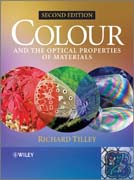
Colour and the optical properties of materials: an exploration of the relationship between light, the optical properties of materials and colour
Tilley, Richard J.D.
Colour and the Optical Properties of Materials carefully introduces the science behind the subject, along with many modern and cutting-edge applications, chosen to appeal to today's students. For science students, it provides a broadintroduction to the subject and the many applications of colour. To more applied students, such as engineering and arts students, it provides the essentialscientific background to colour and the many applications. INDICE: Contents Preface 1 Light and Colour 1.1 Colour and light 1.2 Colour and energy 1.3 Light waves 1.4 Interference 1.5 Light waves and colour 1.6 Black body radiation and incandescence 1.7 The colour of incandescent objects 1.8 Photons 1.9 Lamps and lasers 1.10 Vision 1.11 Colour perception 1.12 Additive coloration 1.13 The interaction of light with a material 1.14 Subtractive coloration 1.15 Electronic paper 1.16 Appearance and transparency 1.17 Further reading 1.18 Problems and exercises Appendix 1.1 Definitions, units and conversion factors 2 Colours due to Refraction and Dispersion 2.1 Refraction and therefractive index of a material 2.2 Total internal reflection 2.3 Refractive index and polarisability 2.4 Refractive index and density 2.5 Invisible animals, GRINS and mirages 2.6 Dispersion and colours produced by dispersion 2.7 Rainbows and halos 2.8 Halos 2.9 Fibre optics 2.10 Negative refractive index materials 2.11 Further reading 2.12 Problems and exercises 3 The Production of Colour by Reflection 3.1 Reflection from a single surface 3.2 Interference at a single thin film in air 3.3 The colour of a single thin film in air 3.4 The reflectivity of a single thin film in air 3.5 The colour of a single thin film on a substrate 3.6 The reflectivity of a single thin film on a substrate 3.7 Low-reflection and high-reflection films 3.8 Multiple thin films 3.9 Fibre Bragg Gratings 3.10 Smart windows 3.11 Photonic engineering in nature 3.12 Further reading 3.13 Problems and exercises Appendix 3.1 The colour of a thin film in white light 4 Polarisation and crystals 4.1 Polarisation of light 4.2 Polarisation by reflection 4.3 Polars 4.4 Crystal symmetry and refractive index 4.5 Double refraction: calcite as an example 4.6 The description of double refraction effects 4.7 Colour produced by polarisation and birefringence 4.8 Pleochroism and dichroism 4.9 Nonlinear effects 4.10 Frequency matching and phase matching4.11 More on second harmonic generation 4.12 Optical activity 4.13 Liquid crystals 4.14 Further reading 4.15 Problems and exercises 5 Colour due to Scattering 5.1 Scattering and extinction 5.2 Tyndall blue and Rayleigh scattering 5.3Blue skies, red sunsets 5.4 Scattering and polarisation 5.5 Mie scattering 5.6 Blue eyes and some blue feathers 5.7 Paints, sunscreens and related matters 5.8 Multiple scattering 5.9 Gold sols and ruby glass 5.10 The Lycurgus Cup 5.11 Further reading 5.12 Problems and exercises 6 Colour due to Diffraction 6.1 Diffraction and colour production by a slit 6.2 Diffraction and colour production by a rectangular aperture 6.3 Diffraction and colour production by a circular aperture 6.4 The diffraction limit of optical instruments 6.5 Colour production by linear diffraction gratings 6.6 Two-dimensional gratings 6.7 Estimation of the wavelength of light by diffraction 6.8 Diffraction by crystals and crystal-like structures 6.9 Disordered diffraction gratings 6.10 Diffraction bysub-wavelength structures 6.11 Holograms 6.12 Further reading 6.13 Problems and exercises 7 Colour from Atoms and Ions 7.1 The spectra of atoms and ions 7.2 Terms and levels 7.3 Atomic spectra and chemical analysis 7.4 Fraunhofer lines and stellar spectra 7.5 Neon signs and early plasma displays 7.6 The helium-neon laser 7.7 Sodium and mercury street lights 7.8 Transition metals and crystal field colours 7.9 Crystal field splitting, energy levels and terms 7.10 The colour of ruby 7.11 Transition-metal-ion lasers 7.12 Emerald, alexandrite and crystal field strength 7.13 Crystal field colours in minerals and gemstones7.14 Colour as a structural probe 7.15 Colours from lanthanide ions 7.16 The neodymium (Nd3+) solid state laser: a four level laser 7.17 Amplification of optical fibre signals 7.18 Transition metal and lanthanide pigments 7.19 Spectral hole formation 7.20 Further reading. 7.21 Problems and exercises. Appendix 7.1 Electron configurations Appendix 7.2 Terms and levels 8 Colour from Molecules 8.1 The energy levels of molecules 8.2 The colours arising in some simple inorganic molecules 8.3 The colour of water 8.4 Chromophores, chromogens and auxochromes 8.5 Conjugated bonds in organic molecules: the carotenoids 8.6 Conjugated bonds circling metal atoms: porphyrins and phthalocyanines 8.7 Naturally occurring colorants: flavonoid pigments 8.8 Autumn leaves 8.9 Some dyes and pigments 8.10 Charge transfer colours 8.11 Colour change sensors 8.12 Dye lasers 8.13 Photochromic organic molecules 8.14 Further reading 8.15 Problems and exercises 9 Luminescence 9.1 Luminescence 9.2 Activators, sensitizers and fluorophores 9.3 Atomic processes in photoluminescence 9.4 Fluorescent lamps 9.5 Plasma displays 9.6 Cathodoluminescence and cathode ray tubes (CRTs) 9.7 Field emission displays (FEDs) 9.8 Phosphor electroluminescent displays 9.9 Upconversion 9.10 Quantum cutting 9.11 Fluorescent molecules 9.12 Fluorescent nanoparticles 9.13 Fluorescent markers and sensors 9.14 Chemiluminescence and Bioluminescence 9.15 Triboluminescence 9.16 Scintillators 9.17 Further reading 9.18 Problems and exercises 10 Colour in Metals, Semiconductors and Insulators 10.1 The colours of insulators 10.2 Excitons 10.3 Impurity colours in insulators 10.4 Impurity colours in diamond 10.5 Colour centres 10.6 The colours of semiconductors 10.7 The colours of semiconductor alloys 10.8 Light emitting diodes (LEDs) 10.9 Semiconductor diode lasers 10.10 Semiconductor nanostructures 10.11 Organic semiconductors and electroluminescence 10.12 Electrochromic films 10.13Photovoltaics 10.14 Digital photography 10.15 The colours of metals 10.16 Thecolours of metal nanoparticles 10.17 Extraordinary light transmission and plasmonic crystals 10.18 Further reading 10.19 Problems and exercises Answers to questions Index
- ISBN: 978-0-470-74696-7
- Editorial: John Wiley & Sons
- Encuadernacion: Cartoné
- Páginas: 504
- Fecha Publicación: 17/12/2010
- Nº Volúmenes: 1
- Idioma: Inglés
